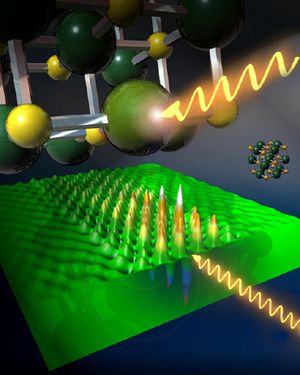إكسايتون

الإكسايتون exciton هو مستوى الطاقة المقيّد لإلكترون وفجوة إلكترون اللذين ينجذبان لبعضهما البعض بقوة كولوم. وهو شبه جسيم محايد كهربائياً يتواجد في العوازل وأشباه الموصلات)، وبعض السوائل. ويُعتبر الإكسايتون كإثارة ابتدائية للمادة المكثفة بإمكانها نقل الطاقة بدون نقل الشحنة الكهربائية الخالصة.[2]
ويتشكل الإكسايتون عندما يُمتص فوتون بواسطة شبه موصل. ويؤدي ذلك إلى إثارة إلكترون من نطاق التكافؤ إلى نطاق التوصيل. وبدوره، فإن ذلك يترك خلفه فجوة موجبة الشحنة محلية. ثم ينجذب الإلكترون في نطاق التوصيل إلى تلك الفجوة المحلية بواسطة قوة كولوم. هذا الانجذاب يعطي توازن طاقة يضفي استقراراً. وبالتالي، يكون للإكسايتون طاقة أقل بدرجة طفيفة عن الإلكترون غير المقيد والفجوة. الدالة الموجية للحالة المقيـَّدة يقال لها هيدروجينية، وهي حالة ذرة غريبة شبيهة بتلك لذرة هيدروجين. إلا أن الطاقة المقيدة هي أصغير كثيراً وحجم الجسيم أكبر كثيراً من ذرة الهيدروجين. وذلك بسبب كل من غربلة قوة كولوم بإلكترونات أخرى في شبه الموصل (أي ثابت العازل له)، والكتل الفعالة الصغيرة للإلكترون المثار والفجوة. إعادة جمع الإلكترون والفجوة، أي انحلال الإكسايتون، يحده تثبيت التناغم بسبب تراكب الدوال الموجية للإلكترون والفجوة، مما ينتج عنه عمر أطول للإكسايتون.
وقد يكون للإلكترون والفجوة لفات مغزلية متوازية أو مضادة التوازي. وتقترن اللفات بتفاعل تبادلي، ينتج عنه البنية الدقيقة للإكسايتون. ففي العقود الدورية، تـُظهر خصائص الإكسايتون اعتماداً على العزم (المتجه k).
مفهوم الإكسايتون اقترحه لأول مرة ياكوڤ فرنكل في 1931،[3] عندما وصف إثارة ذرات في عقد من العوازل. وقد اقترح أن هذه الحالة المثارة سيكون بإمكانها السفر بطريقة شبيهة بالجسيمات عبر العقد بدون انتقال خالص للطاقة.
التصنيف
يمكن معاملة الإكسايتونات في حالتين مقيـِّدتين، حسب خصائص المادة موضع الدراسة.
إكسايتونات فرنكل
في المواد ذات ثابت العزل الصغير، قيد يكون تفاعل كولوم بين الإلكترون والفجوة قوياً ولذا تنحى الإكسايتونات لأن تكون صغيرة، بنفس درجة الخلية الوحدة. بل قد تقع الإكسايتونات الجزيئية بالكامل في نفس الجزيء، كما في الفولرينات. وفي تلك الحالات، فالإلكترون والفجوة يقعان ضمن نفس الخلية الوحدة. هذا الإكسايتون فرنكل Frenkel exciton، على اسم ياكوڤ فرنكل، له طاقة مقيدة نمطية من درجة 0.1 إلى 1 eV. وتتواجد إكسايتونات فرنكل في بلورات الهاليدات القلوية وفي البلورات الجزيئية العضوية المكونة من جزيئات عطرية.
إكسايتونات وانير
In semiconductors, the dielectric constant is generally large. Consequently, electric field screening tends to reduce the Coulomb interaction between electrons and holes. The result is a Wannier exciton,[4] which has a radius larger than the lattice spacing. As a result, the effect of the lattice potential can be incorporated into the effective masses of the electron and hole. Likewise, because of the lower masses and the screened Coulomb interaction, the binding energy is usually much less than a hydrogen atom, typically on the order of 0.01eV. This type of exciton was named for Gregory Wannier and Nevill Francis Mott. Wannier-Mott excitons are typically found in semiconductor crystals with small energy gaps and high dielectric constant, but have also been identified in liquids, such as liquid xenon.
In single-wall carbon nanotubes, excitons have both Wannier-Mott and Frenkel character. This is due to the nature of the Coulomb interaction between electrons and holes in one-dimension. The dielectric function of the nanotube itself is large enough to allow for the spatial extent of the wave function to extend over a few to several nanometers along the tube axis, while poor screening in the vacuum or dielectric environment outside of the nanotube allow for significant binding energies of 0.4 to 1.0 eV.
Often there is more than one band to choose from for the electron and the hole leading to different types of excitons in the same material. Even high-lying bands can be effective as فمتوثانية two-photon experiments have shown.
إكسايتونات سطحية
At surfaces it is possible for so called image states to occur, where the hole is inside the solid and the electron is in the vacuum. These electron hole pairs can only move along the surface.
إكسايتونات ذرية وجزيئية
Alternatively, an exciton may be thought of as an excited state of an atom, ion, or molecule, the excitation wandering from one cell of the lattice to another.
When a molecule absorbs a quantum of energy that corresponds to a transition from one molecular orbital to another molecular orbital, the resulting electronic excited state is also properly described as an exciton. An electron is said to be found in the lowest unoccupied orbital and an electron hole in the highest occupied molecular orbital, and since they are found within the same molecular orbital manifold, the electron-hole state is said to be bound. Molecular excitons typically have characteristic lifetimes on the order of nanoseconds, after which the ground electronic state is restored and the molecule undergoes fluorescence. Molecular excitons have several interesting properties, one of which is energy transfer (see Förster resonance energy transfer) whereby if a molecular exciton has proper energetic matching to a second molecule's spectral absorbance, then an exciton may transfer (hop) from one molecule to another. The process is strongly dependent on intermolecular distance between the species in solution, and so the process has found application in sensing and molecular rulers.
انظر أيضاً
الهامش
- ^ Abbamonte Research Group, University of Illinois
- ^ Liang, W Y (1970). "Excitons". Physics Education. 5: 226. doi:10.1088/0031-9120/5/4/003.
- ^ Frenkel, J. (1931). "On the Transformation of light into Heat in Solids. I". Physical Review. 37: 17. doi:10.1103/PhysRev.37.17.
- ^ Wannier, Gregory (1937). "The Structure of Electronic Excitation Levels in Insulating Crystals". Physical Review. 52: 191. doi:10.1103/PhysRev.52.191.